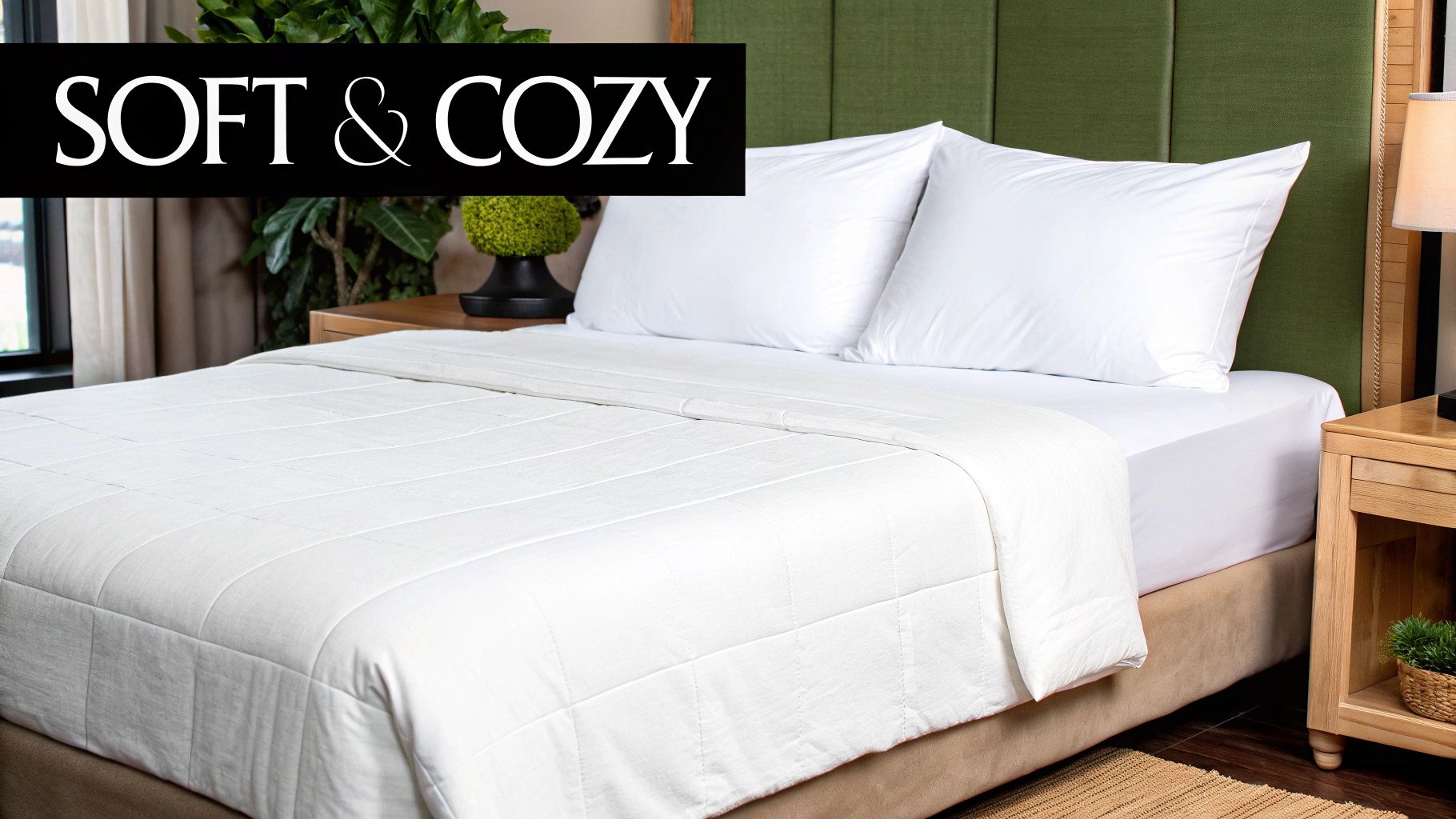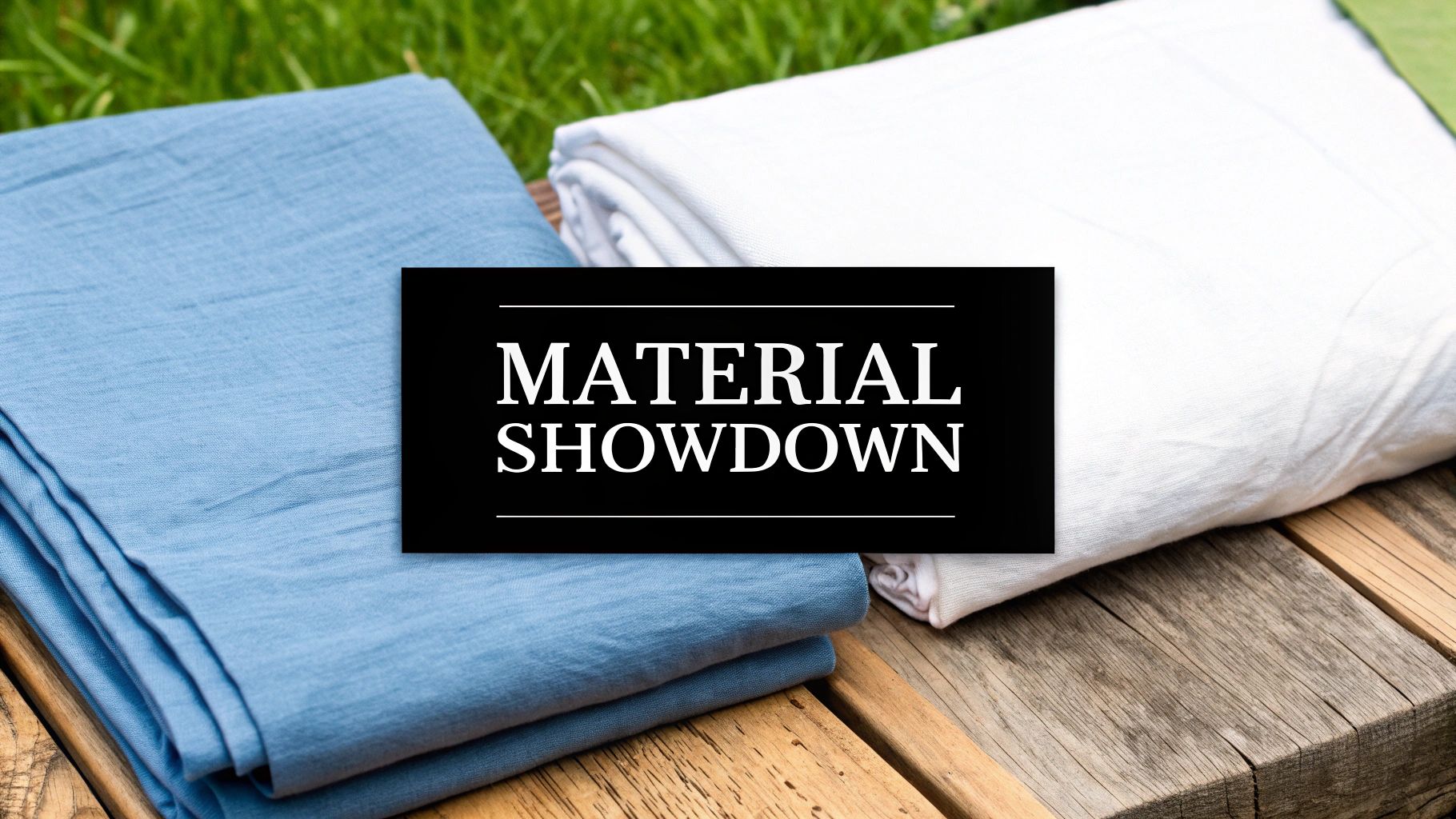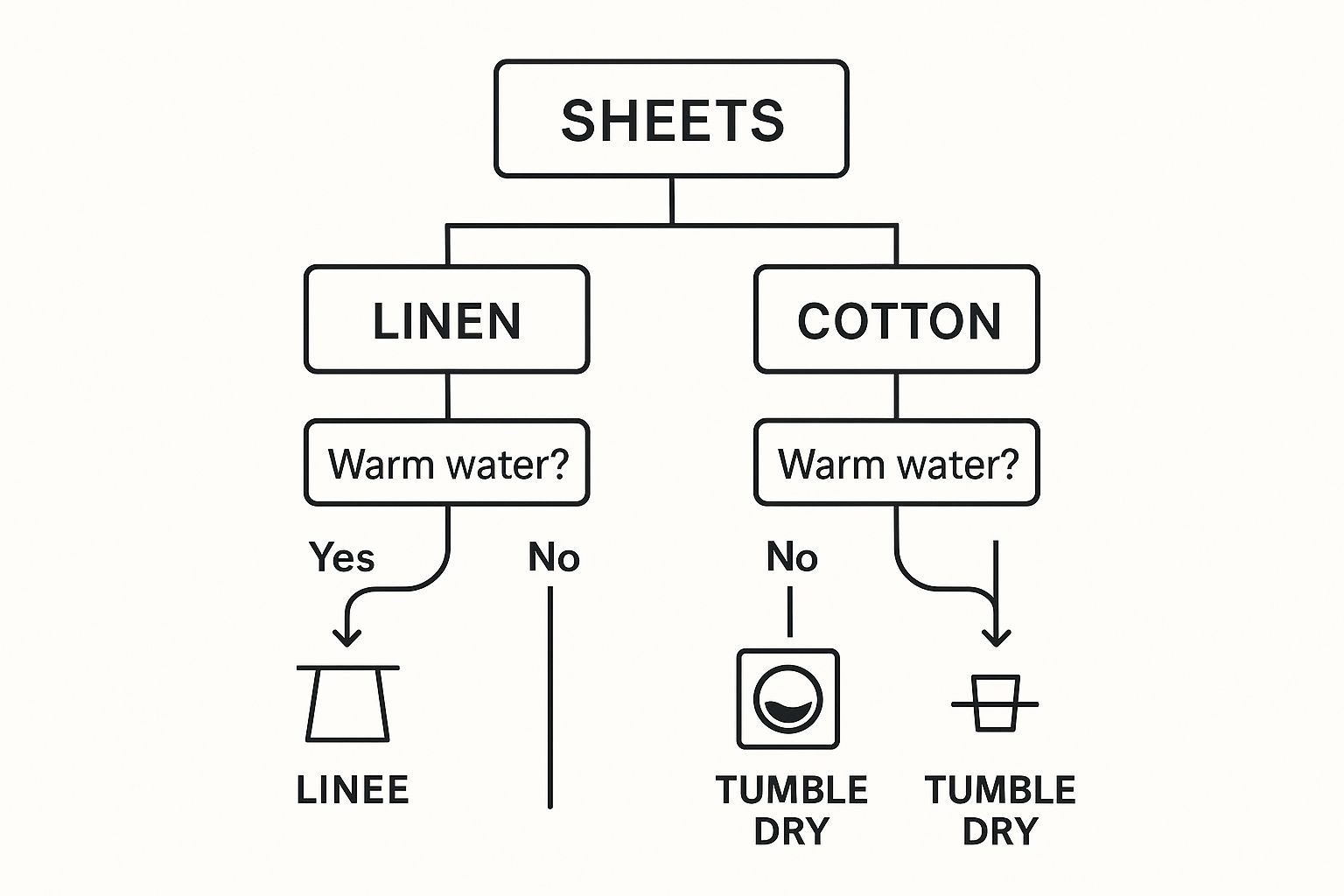When it comes down to it, the choice between linen and cotton sheets is really about what you value most in your bedding. Linen brings an almost unmatched level of breathability and a beautifully relaxed, lived-in style. On the other hand, cotton offers that familiar, classic softness and comes in a much wider variety of textures, from crisp percale to silky-smooth sateen.
Ultimately, your perfect sheet depends on what you're looking for. Do you want airy, temperature-regulating performance for a better night's sleep, or do you prefer the immediate comfort of smooth, classic fabric?
A Guide to Choosing Your Perfect Sheets

Choosing between linen and cotton isn’t just about the fabric itself; it’s about consciously creating the sleep sanctuary you deserve. This guide will take you beyond surface-level preferences, giving you a practical framework to select bedding that truly suits your sleep habits, your home’s climate, and your personal sense of style.
We’ll dig into what makes each material unique. From linen's wonderfully airy texture, which comes from the fibres of the flax plant, to the diverse softness found in high-quality cottons, the goal is to arm you with knowledge. Understanding these nuances is key to finding sheets that offer both enduring comfort and real value.
Making this choice is no small matter for many homes. Here in New Zealand, the household linen market was valued at around USD 418.77 million in 2023, which shows just how much we care about quality bedding. What’s more, there’s a growing trend towards sustainable and eco-friendly materials, which is changing how we approach these purchases. If you're interested in the numbers, you can find more data on NZ's household linen market in ReportLinker's market analysis.
To help you see the core differences at a glance, here’s a quick breakdown:
| Feature | Linen Sheets | Cotton Sheets |
|---|---|---|
| Primary Source | Fibres from the flax plant | Fibres from the cotton plant |
| Feel | Initially crisp, but becomes incredibly soft with every wash. Textured and airy. | Can feel crisp (percale) or silky-smooth (sateen) right from the start. |
| Best For | Hot sleepers, humid climates, and anyone wanting a relaxed, natural aesthetic. | Those who value that 'out-of-the-box' softness, a polished look, or specific weaves. |
| Durability | Exceptionally strong and long-lasting. A good set can easily outlive cotton. | Durability depends heavily on quality (like Supima®) and weave. |
| Care | Very low-maintenance. Its natural, slightly wrinkled look is part of its charm. | Needs more effort (like ironing) if you want to keep a crisp, smooth finish. |
In the rest of this guide, we'll dive deeper into each of these points. We’ll provide the detailed, real-world insights you need to confidently decide whether linen or cotton is the right choice for your home.
Comparing the Feel and Sleep Experience

When it comes to choosing between linen and cotton, what the sheets actually feel like is often the final decider. The sensation of fabric against your skin is a deeply personal preference, going far beyond a simple word like 'soft'. It's a crucial part of improving your overall sleep quality, and each material delivers a very different experience.
Linen has a character all its own, and it's one that evolves beautifully. Straight out of the packaging, linen has a satisfyingly crisp, textured feel that speaks to its natural flax origins. It isn’t rough; it’s substantial and breathable, with a visible weave that gives it that relaxed, almost rustic charm.
But the real magic of linen happens over time. With every single wash, the fibres begin to relax and soften, transforming the fabric into something incredibly supple and gentle. This is precisely why well-loved linen sheets are so treasured. They develop a personalised softness that feels both luxurious and deeply comforting—a journey from crisp to cosy that cotton just doesn't take.
The Diverse Feel of Cotton Sheets
Cotton, on the other hand, gives you a more immediate and familiar softness. Its feel, however, is almost entirely determined by its weave. You really need to understand the two main types to know if cotton is the right choice for you.
-
Percale Weave: Picture a classic, high-end hotel bed. That’s percale. It's light, crisp, and wonderfully cool to the touch. The simple one-thread-over, one-thread-under weave creates a matte finish and a breathable fabric that’s perfect if you dislike the clingy feeling of silkier sheets.
-
Sateen Weave: If you’re chasing a silky-smooth, almost buttery feel, sateen is what you're after. This weave construction places more threads on the surface, which results in a subtle lustre and a fluid drape that feels exceptionally smooth against the skin. It’s a warmer and denser weave than percale.
The initial feel of cotton is often what draws people in—it's familiar and instantly comforting. Linen, however, offers a transformative experience, rewarding your patience with a uniquely soft, lived-in feel that gets better with every year of use.
Ultimately, the choice comes down to the sensation you're looking for when you slide into bed. Do you want the consistent, tailored softness of cotton, whether crisp or silky? Or are you drawn to the evolving, textured character of linen that becomes uniquely yours over the years? To get the most from your choice, you might be interested in our guide on https://www.thefoxesden.co.nz/blogs/the-foxes-den-blog/290.
How Linen and Cotton Perform Night After Night

Beyond that first touch, the real test of any sheeting is how it holds up night after night. This is where the core differences between linen and cotton truly surface, especially when it comes to breathability, how they handle moisture, and their long-term durability. When you're deciding between linen or cotton sheets, these performance factors are what ultimately shape your satisfaction.
Linen is an absolute champion at keeping you comfortable through warm or humid nights. The magic is in the unique structure of the flax fibres. Being hollow, these fibres allow air to move through the fabric with incredible ease, creating a kind of natural, built-in ventilation system.
This hollow structure also makes linen a moisture-wicking powerhouse. It can actually absorb up to 20% of its own weight in moisture before you’d even start to feel any dampness. For anyone who sleeps hot or lives in a climate like New Zealand’s, this translates to a much drier and more comfortable sleep.
Breathability and Moisture Control
Now, cotton also breathes well, there's no denying it. A good quality percale weave, in particular, has a crisp, open structure that allows for plenty of airflow, stopping you from feeling stuffy. It offers that reliable, all-season comfort that so many of us know and love.
The catch, however, is that cotton fibres tend to trap moisture rather than release it. While the fabric breathes, it doesn't actively pull moisture away from your skin with the same gusto as linen. In humid weather, cotton sheets can start to feel a bit clammy, whereas linen is constantly working to keep the sleep surface feeling dry and fresh.
Linen's hollow fibres create a superior microclimate, actively managing both temperature and moisture. Cotton offers a more passive breathability, providing comfort in moderate conditions but lacking linen’s high-performance moisture control in warmer, more humid environments.
This distinction is what really matters if your sleep is easily disrupted by overheating or night sweats. Think of linen as a high-performance fabric, while cotton provides consistent, everyday comfort.
Long-Term Durability and Ageing
When you start thinking about the lifespan of your bedding, linen is in a league of its own. The flax plant produces incredibly long, strong fibres, giving linen sheets a remarkable strength and resilience. They are famously durable and, with the right care, can honestly last for decades.
But here’s the most impressive part: linen doesn’t just last, it gets better. With every wash, the fibres gently relax and soften, becoming more supple and luxurious over time. This means your investment doesn't just endure; it actually improves with every year of use.
Cotton's durability is respectable, but it can’t quite go the distance with linen. A high-end set of cotton sheets, like those made from Supima®, will certainly serve you well for many years. However, after countless washes, cotton fibres are simply more susceptible to thinning, weakening, and eventually pilling.
- Linen Durability: Its fibres are inherently stronger and longer, which means they resist wear and tear exceptionally well. You're far less likely to see pilling or holes develop.
- Cotton Durability: Strength really comes down to the quality of the cotton (the staple length) and the weave. Cheaper, lower-quality cottons might start showing their age within just a few years.
At the end of the day, linen is the clear winner if longevity is your top priority. While premium cotton offers good service, linen is an investment that pays you back with years—even decades—of improving comfort.
Breaking Down the Cost: Investment vs. Expense
When you’re weighing up linen and cotton sheets, the price is often the first thing you notice. Let's be upfront: linen almost always has a higher initial price, and that can be a big deciding factor for many of us.
This price difference isn't just for show. It comes down to how each material is made. Getting from a flax plant to a finished linen sheet is a complex, hands-on process that’s much less industrialised than cotton production. This careful approach gives us an incredibly durable fabric, but it also means a higher cost. Cotton, on the other hand, is produced on a massive scale with incredible efficiency, which is why you can find it at nearly every price point, from budget-friendly basics to high-end luxury weaves.
Beyond the Initial Price Tag
While cotton is definitely easier on the wallet at first, looking at the true cost means thinking about long-term value. This is where linen starts to really shine, often proving to be the more economical choice over its lifetime. Its natural strength is legendary; a quality set of linen sheets can genuinely last for decades, not just a few years.
This incredible durability means you won't be replacing them nearly as often as you would even the best cotton sheets, which can start showing their age after a few years of regular washing and use. It’s also interesting to look at the cotton market itself. For example, import prices for cotton bed linen in New Zealand can vary quite a bit depending on where it’s from. Cotton from suppliers in Pakistan often carries a higher price than that from China or Bangladesh, which tells you there are different tiers of quality even within the cotton world. You can find more data showing how market dynamics influence cotton pricing in NZ if you're curious.
I always encourage people to think of linen as a long-term investment in their home and their sleep. The higher upfront cost is balanced by its incredible lifespan. You buy it once, and you buy it well, potentially saving money over a decade compared to replacing cotton sets multiple times.
Defining What 'Value' Means to You
At the end of the day, 'value' is about more than just how long something lasts. It’s also about how it makes you feel—the quality of your sleep and the simple pleasure your bedding brings you every single night. For some people, the immediate, crisp-yet-soft feel of high-thread-count cotton is absolutely worth it. If that sounds like you, we have a great guide to achieving that signature lived-in look and feel you might enjoy.
For others, the unique character of linen is what truly matters. Its unmatched breathability, its effortlessly relaxed style, and the beautiful way it softens with every wash offers a kind of value that goes far beyond the initial price. The best choice really comes down to what you prioritise: upfront savings or long-term performance and enduring style.
The Environmental Impact of Your Bedding
When you're choosing between linen and cotton sheets, you're not just deciding on comfort—you're making an environmental choice that starts in the soil. For anyone who cares about sustainability, understanding the backstory of each fabric is key to making a purchase you can feel good about. It all comes down to their source plants and the resources needed to grow them.
Linen comes from the flax plant, a wonderfully resilient crop. It's not fussy, thriving in poor soil and often getting by on natural rainfall alone, which means it requires significantly less water than conventional cotton. Because flax is naturally pest-resistant, farmers can use far fewer pesticides and herbicides, lightening the chemical load on the environment.
A Tale of Two Cottons
When we talk about cotton, it’s crucial to know that not all cotton is created equal. There's a world of difference between conventional and organic farming methods. Conventional cotton is one of the thirstiest crops on the planet, demanding huge amounts of water and accounting for a massive slice of the world's insecticide use. Its environmental toll can be pretty steep.
This is where certified organic cotton comes in as a much kinder alternative. It's grown without any synthetic pesticides, herbicides, or genetically modified organisms. These farming practices are designed to maintain healthy soil, protect local ecosystems, and use substantially less water. Opting for organic really closes the gap, bringing cotton much closer to linen's naturally low-impact profile.
When you look at the entire lifecycle of your bedding, from the farm to your bedroom, linen often has a natural edge thanks to its minimal need for water and chemicals. For cotton lovers, the single most important thing you can do for the planet is to choose certified organic.
Certifications and End of Life
So, how do you know what you're really buying? Look for trusted certifications. The Global Organic Textile Standard (GOTS) is your assurance that a product is genuinely organic from seed to stitch, covering both farming and ethical processing. Meanwhile, Oeko-Tex certifies that the finished fabric is completely free from harmful substances. You can learn more about this in our guide to sustainable bedding.
The good news is that both pure linen and 100% cotton are plant-based, which means they are biodegradable and can be composted at the end of their long lives—as long as they aren't blended with synthetic fibres. To get a better handle on what this means for disposing of your old sheets, it’s helpful to understand the difference between compostable versus recyclable materials. This knowledge helps ensure your bedding returns to the earth gently, completing a truly sustainable cycle.
So, which sheets are right for your lifestyle?
When it comes down to it, the choice between linen and cotton is deeply personal. To help you decide, let's look past the general specs and dive into how each fabric fits into real-world scenarios. By matching your daily habits and sleep preferences to the unique strengths of linen or cotton, you'll find your perfect match.
This simple guide can help you visualise the basic care routines involved, a key consideration for any lifestyle.

As you can see, the day-to-day care is slightly different. Linen’s strong fibres appreciate gentler drying, while cotton holds up well to a standard machine dry.
Tailored Recommendations for Your Needs
Let's pinpoint your ideal bedding based on what matters most to you. Each scenario below highlights a clear winner and explains exactly why it’s the best fit for that specific need.
For the Hot Sleeper If you’re constantly throwing off the covers or waking up feeling too warm, linen is your undeniable champion. The secret is in its hollow fibres, which give it fantastic breathability and moisture-wicking power. It actively pulls heat and sweat away from your body, keeping you cool and dry all night long in a way that cotton just can’t quite match.
For the Softness Seeker Is your top priority a silky-smooth feel right from the get-go? Then a high-quality cotton sateen is the perfect choice. While linen becomes incredibly soft over time, sateen delivers that luxurious, smooth sensation straight out of the package. It drapes beautifully and feels wonderfully gentle against the skin from the very first night.
Linen’s softness is a journey; it evolves and deepens with every wash, rewarding your patience. Cotton, especially sateen, offers instant gratification with a familiar, consistent softness.
For the Durability Investor If you see your bedding as a long-term investment and value longevity above all, linen is the superior option. It’s renowned for its inherent strength, often lasting for decades while becoming more supple with every wash. Linen resists pilling and wear far better than cotton, which makes the higher initial cost a truly worthwhile investment in enduring quality.
For the Low-Maintenance Household For anyone who loves an effortlessly stylish bedroom without the fuss, linen’s relaxed aesthetic is ideal. It embraces its natural wrinkles as part of its charm, so you can happily skip the ironing. On the other hand, cotton—particularly a crisp percale—often needs ironing to look neat and tidy. This difference is quite telling in New Zealand, where printed cotton remains a popular choice. In 2022, the country imported around 1,600 metric tonnes of cotton bed-linen, valued at approximately NZD 17 million, with much of it sourced from Pakistan and China. You can dig deeper into this by exploring the bed-linen trade data on WITS World Bank.
Linen vs Cotton at a Glance
For a quick summary, this table breaks down the key differences to help you make a final decision.
| Attribute | Linen Sheets | Cotton Sheets |
|---|---|---|
| Feel | Initially crisp, becomes exceptionally soft with use. Textured and weighty. | Can be crisp (percale) or silky (sateen) from the first use. |
| Breathability | Excellent. Hollow fibres offer superior airflow and moisture-wicking. | Good. Percale is more breathable than the denser sateen weave. |
| Best For | Hot sleepers, durability investors, and those wanting a relaxed look. | Softness seekers, those on a budget, and fans of a crisp, classic look. |
| Durability | Extremely durable. Can last for decades and gets stronger when wet. | Less durable than linen. High-quality cotton can last years but may pill. |
| Care | Easy to wash, but air drying is recommended. Embraces a wrinkled look. | Easy to machine wash and dry. Often requires ironing for a smooth finish. |
Ultimately, choosing between these two amazing natural fibres depends entirely on what you value most in your bedding—be it instant softness, lasting durability, or a cool night's sleep.
Your Questions, Answered
Choosing between these two incredible fabrics often brings up a few final, practical questions. Let's clear up some of the most common queries so you can decide with total confidence.
Which Fabric is Better for Allergies?
For those with allergies or sensitive skin, both high-quality linen and cotton can be fantastic choices, provided they're certified free from harmful chemicals. Your best bet is to look for the Oeko-Tex Standard 100 certification on either fabric, which guarantees it's been tested for and cleared of toxic substances.
That said, linen often has a slight edge here. Its natural moisture-wicking ability and looser weave create an environment that’s less welcoming for dust mites and bacteria, which tend to prefer dampness. If you’re especially prone to allergies, linen's knack for staying dry and fresh might give you that extra peace of mind.
The real secret to allergy-friendly bedding isn't just the material, but its purity. While linen's structure provides a natural advantage, choosing Oeko-Tex certified sheets—whether they're linen or cotton—is the single most important step in protecting yourself from chemical irritants.
How Can I Make My Linen Sheets Softer?
This is one of the best parts about linen—the easiest way to soften it is simply to use it. Linen fibres are designed to relax and become more supple with every single wash.
If you want to help the process along, here are a few tips:
- Wash your sheets in cool or lukewarm water, as hot water can be a bit harsh on the natural fibres.
- Skip the fabric softener. It can actually coat the material and prevent it from softening naturally.
- Tumble dry on a low heat and pull them out while they’re still just a little damp.
Patience is key. Time and regular use are what truly unlock that famously luxurious, buttery softness of well-loved linen.
Do I Really Have to Iron Linen Sheets?
Not at all! In fact, most people would say you shouldn't. One of linen’s most beloved qualities is its effortlessly relaxed and elegant look, which absolutely includes its natural texture and crinkles. Embracing this "no-iron" aesthetic is part of the charm.
Of course, if you really prefer a crisper finish, you can give them a light iron while they are still slightly damp. This makes the job much quicker and more effective. For most of us, though, skipping the iron is a welcome time-saver and one of the biggest perks of choosing linen.
Here at The Foxes Den, we believe true luxury is found in materials that are as functional as they are beautiful. Whether you're drawn to the evolving softness of pure linen or the classic comfort of cotton, our curated collection is designed to bring a little more beauty into your everyday.
Explore our collection of premium bedding and discover your perfect sleep sanctuary.


